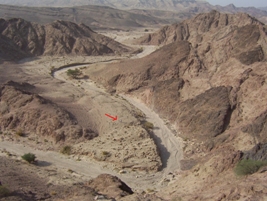
Figure 10: A moving human in the landscape can be seen (c. 500m distant with a c. 200m elevation), here indicated by a red arrow (photo Hannah Friedman).
One way to factor in the limitation of visibility is to create multiple viewsheds that take into account different conditions. In order to model visibility patterns in the Faynan more closely, a limit was set as to how far any viewshed extended. This incorporates ideas discussed by Higuchi (1983), who stated that there are three distances: near-distance; middle-distance; far-distance. Near-distance is the length that individuals and objects are identifiable. Middle-distance is the length to which objects can be seen in the landscape; they can be identified as a type of object but not recognised individually. For example, a tree can be seen but it is not clear which type it is. Finally there is the far-distance, where only large features such as the outline of mountain ranges are visible (Higuchi 1983, 12-14). Employing Higuchi's middle-distance concept, Wheatley and Gillings proposed a limit of 6.2km, stating that this distance is representative of the point past which the human eye cannot clearly distinguish objects (2000, 15-20). However, their estimation was based on Higuchi's study of Japanese forests, an environment very different from the semi-arid desert.
Given the limiting factors commonly present in the Faynan – bright sunlight, dust and pollution – this author considered a visibility range of 6.2km overly optimistic. Therefore for this study three distances were established. These figures were based on personal experience and research in the Faynan, which took place during different seasons. The 'middle distance,' at which an individual can still distinguish large objects, such as the 40m walls of WF1415, or movement of large groups, was chosen to be 4km in excellent conditions. For bad conditions – midday, twilight, smoke or sandstorms – the middle distance was set at 2km. Finally, when monitoring individuals, a 'near distance' limit was established at 1km.
This limit was imposed because a view and the ability to distinguish objects at a distance are two different things. For example, from Khirbet Faynan views can extend to the Wadi Fidan. Although the mountain range can be seen, individuals on it are not distinguishable. What the 4km figure represents is an average estimation of the limit of clear vision and the ability to distinguish objects. The 1km limit was considered to be an appropriate distance in this environment to recognise human beings; while at the very edge of 1km they cannot be individually identified, their general actions can be determined. Given that I am arguing that surveillance was a main mechanism of control, establishing how far one could see is essential, as the ability to discipline by observation diminishes past the limit of 'near distance'.

Figure 10: A moving human in the landscape can be seen (c. 500m distant with a c. 200m elevation), here indicated by a red arrow (photo Hannah Friedman).
The next important point is to model individuals and their heights. Excavations at the Khirbet Faynan cemetery produced complete skeletons and enabled height to be estimated (see Findlater et al. 1998). The smallest male was 1.568m and smallest female was 1.485m. The figure commonly used in viewshed analysis is 1.75m, the average height of a male who has received adequate nutrition. This may not have been the case in the ancient world. The small number of excavated skeletons also contained individuals, both male and female, who were 1.7m in height, but a model should be tested on the lower ends of the scale to ensure its applicability. The representative height of a human adult was chosen to be 1.5m to account for the smaller individuals. With this assumption, when views are created a larger section of the adult population is represented.
© Internet Archaeology/Author(s)
URL: http://intarch.ac.uk/journal/issue27/4/4.2.html
Last updated: Tue Nov 3 2009